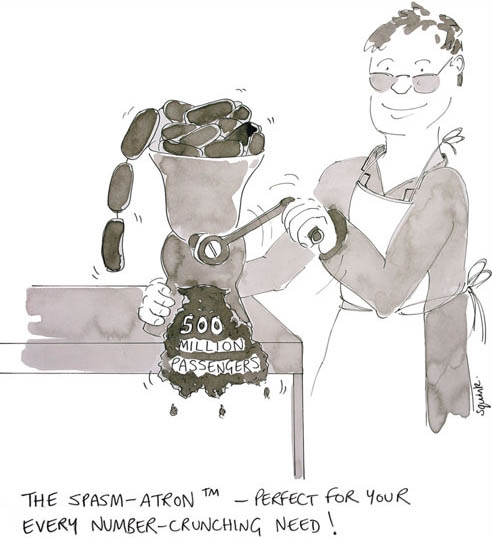5.3.2 How much airport capacity?
The purpose of the UK government’s ‘Air Traffic Forecasts for the United Kingdom’ report (DfT, 2003b), published at the same time as the ‘The Future of Aviation’ document, was to present the passenger demand forecasts as a means of structuring the investigation into options for airport expansion. A private consultancy company, Halcrow, was contracted to work on the DfT’s forecasting models: Second Passenger Allocation Model (SPAM) and then Second Passenger Allocation Simulation Model (SPASM).
(I would like to repeat here the same warning mentioned in my response to Activity 18 about the carbon emissions calculations. Although seemingly very complex, these mathematical models have to make significant simplifications and therefore cannot possibly take into account every possible parameter which will determine actual passenger numbers. Yet, these played a significant role in the decision-making process.)
By 2001, Halcrow had acquired sufficient data to provide a long-term simulation of passenger numbers. The SPASM forecasts of airport capacity produced by Halcrow included several assumptions on the fundamental drivers of long-term air traffic levels. These included:
- people’s increasing desire for travel
- an optimistic outlook for the future health of the UK and the global economy
- the UK’s increasing attractiveness as a global tourist destination
- an acceleration in the globalisation of industry, capital and labour
- increased liberalisation of the air transport industry and competition
- the limits of substitutability of alternative modes of transport, such as rail
- a reduction in the cost base, pricing and operational strategies of the aviation industry
- the increasing competition from hubs in mainland Europe and elsewhere
- the short-term duration of the effects of shocks (such as the terrorist attacks on 11 September 2001)
- the stabilisation of oil price around $25 a barrel.
You may briefly want to assess how reasonable you feel these assumptions might be. The ‘national consultation’ section below shows that a concerted challenge on these assumptions by a range of stakeholders opposed to aviation expansion was made.
Based on these assumptions, the SPASM model outputs recommended a medium-term forecast of 500 million passengers flying by 2030 (as opposed to the 180 million passengers who flew in 2000). The DfT concluded in the ‘Future of Aviation’ consultation document that ‘the overall forecast of 500 million passengers in 2030, assuming airport capacity is accommodating, should be robust’ (DfT, 2003a, p. 5). Thus the government’s forecast was that demand would almost double within the next 20 years.

